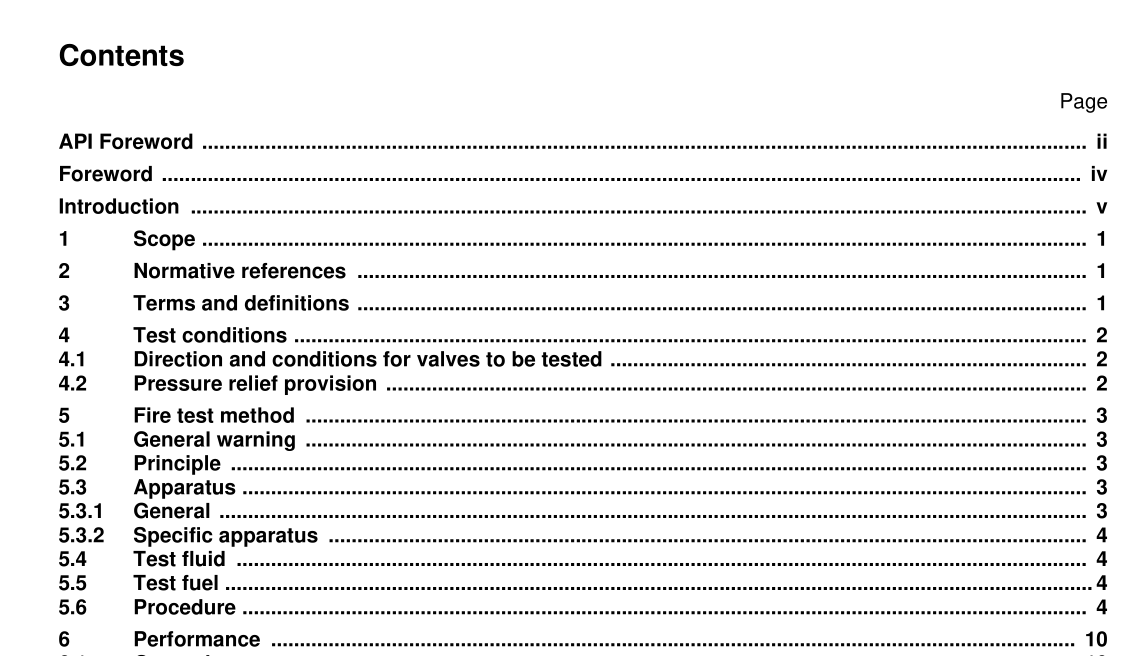API 607 pdf download

API 607 pdf download.Testing of valves — Fire type-testing requirements
5.3 Apparatus
5.3.1 General The test equipment shall not subject the valve to externally applied stress affecting the results of the test. Schematic diagrams of recommended systems for fire type-testing of valves are given in Figure 1. Potential pipework-to-valve end connection joint leakage is not evaluated as part of the test and is not included in the allowable external leakage (see 6.3 and 6.6). For the purposes of this test, it may be necessary to modify these joints to eliminate leakage. The test equipment shall be designed so that if the nominal diameter of the pipework situated immediately upstream of the test valve is larger than DN 25 or one-half the DN of the test valve, the pipework shall be enveloped in flames for a minimum distance of 150 mm from the test valve. The diameter of the upstream pipework shall be sufficient to deliver a flow rate in excess of the maximum allowable leak rate for the size of valve being tested. The pipework downstream of the test valve shall be at least DN 15 and shall be inclined so that the downstream side is fully drained. The flame source shall be at least 150 mm minimum away from the valve or any calorimeters, and should have sufficient capacity to completely envelop the valve in flames. The enclosure containing the valve shall provide a horizontal clearance of a minimum of 150 mm between any part of the test valve and the enclosure, and the height of the enclosure above the top of the test valve shall be a minimum of 150 mm.
5.3.2 Specific apparatus
5.3.2.1 Vapour trap to minimise the cooling effect of the upstream liquid. See Figure 1, (8). 5.3.2.2 Industrial pressure measurement devices having a full-scale reading of between 1,5 and 4 times the pressure being measured. The accuracy of each test device used at any point on the scale shall be within 3 % of its maximum scale value for readings taken both up and down the scale with either increasing or decreasing pressure. See Figure 1, (7), (14). 5.3.2.3 Calorimeter cubes made of carbon steel in accordance with the design and dimensions shown in Figure 2, with a thermocouple of the accuracy specified in 5.3.2.4, located in the centre of each cube. Calorimeter cubes shall be scale-free before exposure to the fire environment. 5.3.2.4 Flame environment and valve body thermocouples of an accuracy at least equal to tolerance class 2 for type B or tolerance class 3 for other types as specified in IEC 60584-2. See Figure 1, (13). 5.3.2.5 Containers of a size suitable for collecting the water leaked from the valve under test. See Figure 1, (18). 5.3.2.6 Calibrated sight gauge or device for measuring the water used during the test. See Figure 1, (4). 5.3.2.7 Calibrated device for measuring the leakage water collected during the test. 5.3.2.8 Pressure relief provision, incorporated in the system, consisting of a pressure relief valve to relieve the test valve centre cavity pressure to the atmosphere, to protect against potential rupture of the valve if it is designed such that liquid can be trapped in the cavity. See Figure 1, (14).
5.6 Procedure
NOTE The numbered items in parentheses refer to the apparatus of Figure 1. 5.6.1 Mount the test valve in the test apparatus so that the stem and bore of the valve are in the horizontal position. Mount a valve that operates in only one direction (unidirectional) in their normal operating position. Locate the flame environment, body thermocouples and calorimeter cubes in the positions shown in Figures 3 and 4, as appropriate. For soft-seated valves up to DN 100 or NPS 4 and pressure ratings up to PN 40, Class 300, use two flame environment thermocouples, two body thermocouples and calorimeter cubes as shown in Figure 3. For all other valves, use two flame environment thermocouples and two calorimeter cubes as shown in Figure 4. For valves DN 200 or NPS 8 and larger, use a third calorimeter cubes as shown in Figure 4.









